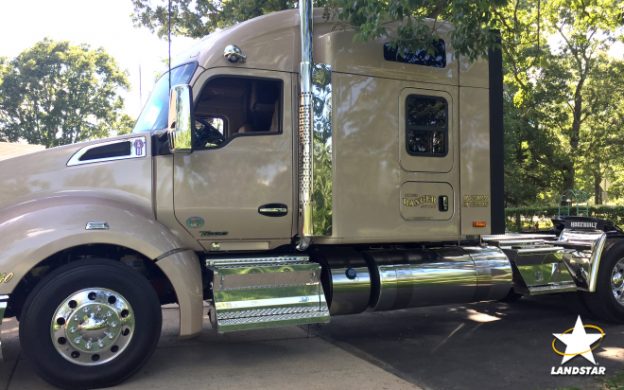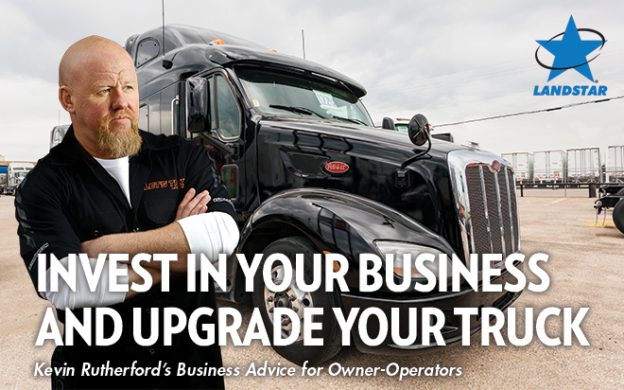Kevin Rutherford, radio host of Trucking Business & Beyond on SiriusXM / Road Dog Trucking, explains to independent owner-operators the importance of investing in new equipment.
Your truck is a tool. A tool that is instrumental for you to run your business and you can’t run a successful business with an inefficient tool. As an owner-operator, investing in a new truck is something that you may have to do a few times in your career in order to stay competitive with large fleets. Large fleets tend to get rid of trucks once they reach 400,000-600,000 miles. Although you may be able to stretch the life span of your truck longer than that if it’s well manufactured and well maintained, you’ll eventually get to a point where you start pouring more money into your truck than what it’s worth.
Costs of an Older Truck vs. Costs of a Newer Truck
There are four major costs that you need to keep in mind as you’re looking at newer trucks – truck payment, truck insurance, fuel and maintenance costs. It’s simple to compare the new payment and insurance costs to what you’re currently paying but fuel and maintenance costs can be a little difficult to calculate. Look for the most reliable sources, do your research and make your best guess. Understand that this isn’t always going to be an absolute numbers game.
Now, think about these costs on a per-mile basis, then compare it to the costs for your current truck. For example, what is your truck payment per mile with your current truck? What would your truck payment per mile be on a newer truck? If you discover that the new costs are similar to the current costs, it doesn’t make sense not to buy a newer truck.
In fact, you may find that purchasing a new truck would be cheaper than maintaining your current truck especially when it comes to fuel costs. Let’s say you have an older truck getting six or seven miles per gallon and see that a newer truck would get you eight or nine miles per gallon. On average, that one or two mile difference could save you $15,000 per year.
Throughout your research, maybe you’ll discover that a new truck is going to financially cost you more but will save you time. Service intervals are longer on new trucks therefore you would spend less time in the shop. Less time in the shop means more time on the road and more money in your pocket.
Purchasing a newer truck is a long-term investment so you need to look long-term before you make a decision. Maybe your purchase won’t save cash today but it could two years from now. The costs of maintaining an older truck will eventually get more expensive and ultimately, you’ll need to invest in a newer truck.
Trucks Made In 2012 and After
It’s hard to forget the years 2004-2011, otherwise known as “the decade of don’t own those engines.” Trucks that were manufactured during this time period were expensive to maintain, had a lot of emission related problems and constantly had to be serviced. Luckily truck manufacturers learned from the mistakes of previous years and implemented newer emission standards in trucks made in 2012 and after. Owning a truck that has these newer emission standards will even get you into California, which could open up a brand new market for you.
The dreaded decade may make you hesitant to purchase a newer truck but trucks have improved a lot since then and continue to do so each year. Pay attention, look around, talk to other owner-operators and you’ll see that purchasing a truck manufactured in 2012 and after is a good investment.
Upgraded Comfort and Safety Features
Thanks to better manufacturing processes and advancements in technology, newer trucks have safety and comfort features that your older truck probably doesn’t have. Some of the safety features common in newer trucks are lane departure warnings, front looking radars, automatic braking and adaptive cruise control. Having a truck with these features will help you remain competitive with other fleets.
Newer trucks are known for being better designed to support the modern truck driver’s lifestyle. The cab and sleepers are comfier and there’s better electrical outputs to sustain your kitchen appliances, laptops and cell phone chargers. While you’re driving, you can expect better aerodynamics, a smoother ride and a reduction in noise.
Investing In Your Business
We are in the autonomous trucking revolution therefore staying up to speed with other carriers and fleets will be crucial to the future of your business. Old trucks will be phased out before you know it and you’ll eventually have to spend the money on a newer truck. Outdated equipment isn’t going to cut it. If you think it’s time to start shopping around for a new truck, remember to look for one that has overall good value, will help you minimize future costs, is equipped with up-to-date safety features, and will be a smart investment for your business.
Kevin Rutherford is a business trainer, author of national articles on trucking and finance, small fleet owner, tax preparer, and radio host of Trucking Business & Beyond on SiriusXM / Road Dog Trucking. He started his career as an owner-operator 30 years ago, running a one-truck operation. He has authored several books on how to be successful as an owner-operator and has given seminars to thousands of owner-operators, drivers, and fleet executives in the U.S. and Canada. He also has prepared thousands of federal and state tax returns for owner-operators and company drivers. Visit www.letstruck.com for more information on Rutherford’s business and tune into his show, Trucking Business & Beyond, on SiriusXM Channel 146 every weekday from 11 a.m. – 2 p.m. ET.






 The November 2018 LCAPP Newsletter is now available on
The November 2018 LCAPP Newsletter is now available on
You must be logged in to post a comment.